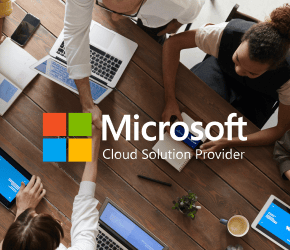If your organisation has ever adopted new technology, the likelihood is that you will, at some time or another, have worked with a Managed Service Provider (MSP) to support your teams. However, the accelerating rate of change – and proliferation of cloud technology alongside our existing investments – has brought new opportunities with a need for evolved skills.
To help us adopt and manage our cloud environments, a new type of MSP – the Cloud MSP – has emerged. Nick Isherwood, Group CIO & Azure Product Director at Advania, discusses the evolution of this type of partner, the relationship and the value that should be expected and the critical service aspects supporting long-term cloud success.
What is a Cloud Managed Service Provider?
Providing managed services is nothing new. For many years, organisations have partnered with MSPs to help them reach their growth potential, digitally transforming operations through the provision of technology and associated services. The most successful MSPs have offered a complete portfolio from strategy and planning to IT support and professional services. They can help identify, deploy and manage a wide range of technology products that truly underpin a long-term vision.
The arrival of cloud technologies has opened up huge potential for organisations – but also new complexities. The Cloud Managed Service Provider (CMSP) builds on traditional foundations but must also be able to help you navigate through myriad cloud offerings to unlock the promise of increased efficiencies and innovation. At the same time, it should provide expertise on cloud security, governance, continuous optimisation and automation.
The way it used to be
For organisations leveraging the power of the cloud today it is perhaps easy to forget the technology landscape that existed just ten years ago. Many enterprises were only beginning to explore public cloud services, with many still preferring the approach of owning and managing IT infrastructure in perhaps a local data centre or regional office.
Understandably, cloud connectivity, security and compliance were still major concerns for organisations at that time. These areas needed to mature considerably before business leaders would adapt thinking and feel comfortable with the prospect of their data being stored, processed and managed by a third party and accessed over the Internet.
Around the same time, organisations relied upon relationships with one or more MSPs. The customer would often have a small IT team, with the MSP plugging the gaps with subject matter expertise and an extensive skills base for incident resolution and delivering ad-hoc specialist projects. Managed service contracts commonly comprised a mix of reactive and proactive services. This would include account management, break/fix support and procurement for hardware and software licensing, with remote monitoring, backup and patching services completing the package. Every five years or so, the customer would reach a natural hardware-refresh decision as their applications became hungrier for compute and storage capacity. The incumbent MSP would build a proposal for the necessary upgrades and, if the service had been satisfactory, the cycle would likely start over. Overall, this relationship was well understood.
So, what changed?
Just after most of us had patted ourselves on the back for virtualising our workloads with Hyper-V and VMWare ESXi to reduce our hardware footprint, there was a new kid on the block. June 2011 saw the wide scale introduction of Office 365, a cloud-delivered productivity suite rich in functionality and sold in a variety of plans as a monthly subscription service. Offered in 40 markets, Office 365 (now Microsoft 365) included MS Office, MS Exchange Online, SharePoint and Lync, delivering an integrated solution for communication and collaboration.
For a huge number of organisations, this was the first real public cloud use case that simply couldn’t be ignored. It served as a catalyst for increased understanding and trust for services delivered in this way. Flexible licensing, evergreen and always up to date, it also triggered a mass exodus from traditional on-premise Exchange servers to an even more reliable email service, which apart from the content and end user device, was managed entirely by Microsoft as Software as a Service (SaaS) and powered by a highly available and global series of data centres. Office 365 offered the same familiar experience but was easier to maintain and paid for as a monthly subscription, just like any ordinary utility.
This shift in the responsibility model for IT infrastructure wasn’t entirely new, however. Some enterprises were already using hosting services for their servers offered on a shared or dedicated hardware basis but managed by private service providers. To many, this was simply an extension of the now familiar virtualisation theme, allowing organisations to rent their infrastructure and access their virtual machines over the Internet or private connection for a predictable monthly cost, with flexibility to scale according to business needs. Importantly, this allowed organisations to budget more accurately for IT spend, avoiding costly capex cycles with what had become known as Infrastructure as a Service (IaaS). This remains popular today as it outsources the underlying platform and management tasks to the MSP but leaves full flexibility from the operating system up with the customer.
Additionally, in 2006 Amazon Web Services (AWS) unveiled the Elastic Cloud Compute (EC2) platform which was the first IaaS offering from today’s hyper-scalers, but it wouldn’t be until 2008 that the service was offered from a European region with a Service Level Agreement (SLA). In the same year, we saw offerings from Google Cloud Platform (GCP) in the shape of Google App Engine, which was a Platform as a Service (PaaS) offering for developing and hosting web applications in Google-managed data centres. Then, in February 2010, came Windows (now Microsoft) Azure, although Project ‘Red Dog’ had been around for many years prior and ultimately formed the fabric of what the Azure platform is today. The public cloud hare was well and truly running and competition for our consumption was hotting up.
There were of course many early adopters of public cloud services, some very successfully building out global applications to get an edge on their competition. It’s worthy of note that many were caught out in the early wave by the elastic nature of the cloud, particularly when it came to governance and cost containment, having made the move to a pay-for-what-you-consume economic model. Lessons were certainly learned here. In some cases organisations needed to rebuild their confidence in how to operate effectively in the cloud, embracing private cloud or a blend of the two rather than placing their eggs in a single basket. At this time, MSPs were considerably less mature in their offerings around cloud management – but they were starting to realise that traditional infrastructure support only scratched the surface of what was needed to comprehensively support a cloud-centric organisation.
How did the cloud change the traditional MSP?
As popularity increased for IaaS, and Office 365 wrote its own business case, it was only a matter of time before the plethora of services provided from public cloud platforms such as AWS, GCP and Microsoft Azure grew in stature and appeal. Today, we are spoilt for choice with models supporting IaaS, PaaS and SaaS and delivering hundreds of integrated service offerings – and the pace of innovation is increasing exponentially. We no longer need to purchase hardware or software licensing as one-off investments. The relationship between customer and service provider has evolved considerably with the cloud revolution.
With public cloud providers offering fully managed platforms for our applications we would be forgiven for thinking that the role of the MSP may have been diminished. The truth is that many of the traditional services remain relevant today, but the complexity of operating across the cloud has brought increasingly advanced expectations for MSPs to help customers navigate the options and build cloud-based operations. Many organisations are operating workloads across hybrid cloud deployments, consuming SaaS based applications, PaaS services such as web and database, and perhaps retaining some legacy applications within their own data centres where it makes sense to do so.
This is where CMSPs, with their investments in subject matter expertise and sophisticated cloud and service management tooling, can really help organisations. They help you accelerate adoption and then securely manage and optimise the distributed environment throughout the cloud life-cycle.
What should I expect from a Cloud Managed Service Provider?
Five things to look for with your CMSP
CMSPs must focus their expertise on critical new areas of cloud management which are both proactive and outcome-based. Their services must be designed to not only support the customer with their successful cloud migration but also the ongoing management and continuous adoption of new cloud services across a hybrid estate. The lines between projects and support have become increasingly blurred, with the growing use of DevOps practices and the increasing rate at which applications are being built and deployed using agile approaches.
Put simply, operating in the cloud should mean you can achieve greater agility and speed, focusing on your applications, data, staff and customer experiences rather than underlying platform maintenance. But to do so requires your cloud, whatever shape this may take, to be expertly managed and optimised.
Below I have listed five of the key areas which should underpin the value added by CMSPs when it comes to ensuring customer success in the cloud.
1. Strategic guidance
- Whilst this has always been the cornerstone of the service provider and customer relationship, the emphasis on strategic guidance only increases with a true end-to-end cloud service provider. The CMSP should not only architect cloud services to support the future direction of the business, but they must also scan the horizon and provide clear communication on developing opportunities that can be taken advantage of and budgeted for as part of your digital roadmap. Such is the pace of change in the cloud, deeply capable CMSPs are organisationally configured to continually assess the changing landscape for you and apply this knowledge to your context. Look for services from the CMSP that offer regular contextual insights into the changing product landscape.
- With transparency over the business strategy, the CMSP should ensure that the technology and supporting services will enable the various user personas in your business to be as productive as possible in their relevant roles to achieve it. For example, this could include segregated development environments for innovation teams, enabling secure, seamless access to line-of-business applications for remote workers, and a scalable blueprint for global infrastructure if international expansion is on the cards. All of this should be coupled with a support experience that enables anyone in your business to get help when and where they need it, from an expert rather than a generalist.
- With such a vast choice of cloud providers, it is inevitable that most CMSPs have experience that’s particularly deep in one or two vendors’ cloud offerings, but lighter in others. The most trusted CMSPs recognise where a particular vendor solution is right for you but not necessarily in their own sweet spot. The CMSP should always put the customer first by calling on one of its ‘inner-circle’ partners for the best-fit solutions. Co-selling products or services is commonplace but the best CMSPs will ensure that this is a seamless experience for you and will remain the central point of engagement throughout.
- Highly prominent CMSPs also maintain exceptionally strong relationships with major cloud platform providers. This relationship can be used to the customer’s advantage with early notification or previews of new products and programmes. You should look at the depth of the relationship that the CMSP has developed with key vendors through their accreditations, contacts and events.
- Working with CMSPs who can offer a variety of integrated cloud solutions to address a given challenge can be very advantageous. For example, providing an end user with a secure and managed desktop experience could be underpinned by a multitude of underlying technologies and approaches. The choice should be driven by a consultative approach to your staff personas and device preferences, with the solution offered from the most appropriate product combinations, rather than a single technology the provider happens to feel most comfortable with.
2. Service management
- The CMSP should have robust, demonstrable processes and accredited engineers for managing reactive incidents, requests and changes available on a 24/7 basis with clearly documented SLAs. These should be evidenced through frameworks or standards such as ISO and Cyber Essentials, along with cloud-vendor-specific, company-level accreditations and competencies. It should provide comprehensive reporting highlighting service performance and opportunities for continuous service improvement. There should be an element of web-based self-service provided to facilitate basic request management such as resetting of passwords or tracking and escalating incidents.
- Your cloud environment should be monitored from both an infrastructure and application performance perspective. The CMSP’s monitoring services should be fully integrated with the IT Service Management platform to expedite events for remediation by appropriately skilled engineers.
- The cloud (particularly IaaS and PaaS) provides increased automation of backups, security updates and failover options. However, these still need to be regularly validated for correct operation and occasionally tested to ensure recovery point objectives and recovery time objectives can be met to support your business continuity plan.
- Capacity management should be an intrinsic part of the service. This will ensure that your infrastructure is architected to deal with projected data growth, application performance needs or seasonal demand.
- For complete peace of mind, and particularly in mid-size or enterprise accounts, CMSPs will align dedicated resource to each customer. This will include an Account Director, Service Delivery or Technical Account Manager and, in many cases, sponsorship from a high-ranking Director should a sensitive matter or the need for a broader escalation arise. The value of this approach cannot be underestimated: it gives the service provider contextual awareness of your business priorities and allows it to truly act as an extension of your organisation.
- Best-practice guidance is now readily available from major cloud providers, such as the Well-Architected-Framework from Microsoft. You should make sure that the core aspects of these frameworks are encompassed by the managed service. They should also provide regular architectural reviews of the infrastructure and application relationship to ensure high availability for existing and new applications as they are first deployed.
3. Cost management
- Most experienced cloud service providers offer tooling that allows budgets and thresholds to be set for cloud consumption, along with ‘tagging’ to associate resources with internal departments or applications for charge-back and show-back. The tooling should provide complete cost transparency and control to the customer with breakdowns per month, per resource or per business unit. Additionally, unified billing approaches across cloud subscriptions help you understand your expenditure and plan ahead.
- In the cloud, it’s easy to attract cost through negligence. The CMSP’s tooling and expertise should help avoid this risk. Good cloud governance should include automated policies that can prevent new resources from being created that could inadvertently attract exorbitant costs, or even the tearing down of resources that are no longer being used.
- Accredited CMSPs will be aware of, and have access to, public cloud providers’ offers and programmes that can significantly reduce your cost of operating cloud resources. For example, they can help you access funding or credits towards cloud migration projects or opportunities to re-purpose existing licensing investments in the cloud, such as Microsoft’s Azure Hybrid Usage Benefit. Many workloads can be cheaper to run in the cloud than on premise but the maximum savings might only be achieved by combining multiple unique licensing offers and discounts.
- Architectural reviews should be regularly performed to ensure you’re making use of alternative deployment models – or newer ones that may have been recently released or in preview. A good example would be using serverless rather than provisioned models for databases that you may only be accessing a few times per month.
- Cost optimisation can be a wide-reaching area, but the experience of the CMSP should easily spot advantages for you to right-size resources or apply cost reservations to resources that are relatively static in their nature, helping you achieve significant long-term operating cost reductions.
- Remember: the cloud is designed to scale up or down based on end-user needs at any given time. Ensuring that platforms, virtual desktops and application licensing are kept in alignment is a shared responsibility between you and your service provider, but the CMSP should provide insights into the environment and associated recommendations to drive cost efficiencies.
4. Security management
- Security and compliance should underpin the entire service experience and is the fundamental premise of any project or upgrade. Ensuring the use of multifactor authentication and role-based access control for cloud resources with the ability for the CMSP to track access by approved engineers into customer environments should be expected and regularly audited.
- The highest-calibre CMSPs will offer security management and monitoring services, using advanced tooling and accredited cyber experts to detect and contain threats, and continually identify and proactively remediate vulnerabilities across the cloud estate.
- The CMSP should operate its services in alignment with your corporate security policy and any compliance and regulatory requirements. You should expect a service which reduces your risks with prompt and clear escalation of security incidents or breaches with confidential reporting to key customer stakeholders.
- Importantly, the CMSP itself must operate policies and training for its staff to ensure the delivery of their services does not add further risk to the customer.
- Firewalls, antivirus software and general housekeeping of identities and accounts within the CMSP and customer systems need to be maintained to the highest of standards to reduce attack vectors. Data encryption and secure methods of storing passwords are essential to protect from data breaches.
5. Automation
- The cloud offers increased efficiencies through automation. A CMSP’s understanding and utilisation of this within their service provision can make a substantial difference to the speed and quality of execution. Using approaches such as Infrastructure as Code to build new services in the cloud from repeatable templates reduces errors, vulnerabilities and time-to-value. For example, if you’re opening a new regional office which requires similar resources to an existing office, these can be quickly deployed in the cloud using IT automation engines and repeatable declarative configuration files with Ansible or Terraform. This may also substantially reduce the cost of professional services for you over the course of the relationship.
- More advanced CMSPs will offer tooling which allows customer-approved staff to provision certain pre-built resources safely and securely via service catalogue items or scripts, with all the governance guardrails in place. This reduces the time it would typically take to manually request and build a simple virtual machine for a developer to test a new application. This self-service automation should also apply default tagging information to the resource or create time-bound deployments to save money. It gives you the freedom to deploy cloud resources whilst avoiding classic missteps which may lead to security alerts or cost escalations. More sophisticated toolsets can identify the cheapest SKU across multiple cloud provider platforms for a specific resource type to run for a period, orchestrating the provisioning process.
- At the time of onboarding a customer into service, opportunities to use automation to automatically deprovision resources according to application usage patterns or staff working hours is an essential consideration. If only 30% of an organisation’s workforce is likely to work through weekends, the number of virtual machines that may need to be online throughout that time could be reduced, thus materially lowering consumption costs. Cloud automation can be used to shut down resources during off-peak times and restart them at a time of your choosing with zero intervention. This also has the benefit of temporarily reducing the attack surface for would-be hacking attempts.
- There are many incredible use cases for automation. Cloud technology not only benefits from it but also provides the engine to deliver it. CMSPs that work across multiple sectors and verticals will possess the experience to help customers identify areas of their business that can benefit from cloud automation to reduce cost, increase efficiency and develop new business processes that require lower manual intervention.
Towards a Cloud Centre of Excellence
Cloud technology represents an enormous opportunity for organisations to streamline their operations and provide new customer experiences. The major cloud providers have made multi-billion dollar investments into data centre platforms with global scale, high availability and built-in security and compliance, enabling us to focus on leveraging the innovation opportunity that the cloud represents. The truth is that organisations would find it difficult to privately replicate the benefits of the hyper-scale public cloud due to economies of scale, or indeed develop the breadth and depth of capability offered by the leading CMSPs.
Business leaders should consider how internal teams can help the organisation maximise its investment in cloud technology and truly operate with greater agility and speed. This is where a Cloud Centre of Excellence (CCoE) function comes in. A CCoE moves away from the traditional approach of centralised command and control through a small number of IT stakeholders which can slow momentum. Instead, it empowers IT-related business units to make decisions while adhering to pre-defined guidelines, self-service and automation. This is the same principle adopted by leading CMSPs to deliver comprehensive cloud managed services and projects to customers and brings various roles together to expedite a solution. The five aspects discussed above are core areas that CMSPs have already embedded to form their CCoE.
The cloud is really about empowering people to achieve more. To facilitate this, there needs to be top-down leadership in establishing relationships across the various IT functions (platforms, networks, project management, developers etc) and instilling agile practices such as DevOps which reduces time-to-value and ensures repeatable processes.
Managed well, the possibilities are endless. But being successful in the cloud is all the more achievable with an accredited and experienced CMSP that can augment an organisation’s internal capabilities. By sharing the strategy and working together, a digital roadmap can be established to ensure alignment of technology investments with business outcomes, developing a mutually rewarding partnership for years to come.
Advania: A Microsoft Gold Partner with an Azure Cloud Centre of Excellence
At Advania we’ve worked with partners large and small, across many sectors, to help them unlock the power of the cloud. Our Cloud Centre of Excellence in Azure is underpinned by our Gold Partnership with Microsoft, 16 Gold Competencies including Cloud Productivity and Cloud Platform, and Advanced Specialisations in Azure Virtual Desktop, Windows Server Migration and SQL Server Migration.
To learn more, watch talks from our experts at our recent virtual event, ‘The Cloud Revolution’, or read about our managed cloud services.






















